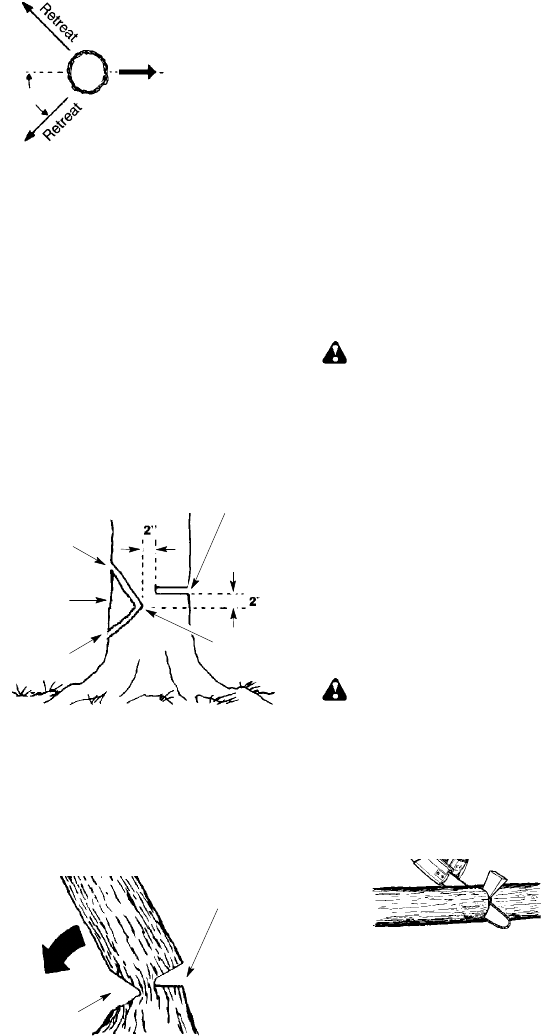
12
Direction of Fall
45_
Plan a clear retreat path
FELLING LARGE TREES
(6 inches in diameter or larger)
The notch methodis used to f elllarge trees.
Anotchiscutonthesideofthetreeinthede-
sired direction of fall. After a felling cut is
made on the opposite side of tree, the tree
will tend to fall into the notch.
NOTE: If the tree has large buttress roots,
removethembeforemakingthenotch. Ifus-
ing saw toremove buttress roots, keep saw
chainfromcontactinggroundtopreventdull-
ing of the chain.
NOTCH CUT AND FELLING THE
TREE
S Make notch cut by cutting the top of the
notch first. Cut through
1/3 ofthediameter
ofthetree.Nextcompletethenotchbycut-
ting the bottom of the notch. See illustra-
tion. Once the notch is cut, remove the
notch of wood from the tree.
Notch
First cut
Second cut
Final (felling) cut here, 2 inches
(5 cm) above center of notch.
Hinge
S After removing the wood from the notch,
make the felling cut on the opposite side of
thenotch.Thisisdoneby makingacutabout
two inches higher than the center of the
notch. This will leave enough uncut wood
between the felling cut a nd thenotch toform
a h inge. This hinge will helpprevent thetree
from falling in the wrong direction.
Opening of
felling cut
Closing
of notch
Hinge holds tree on stump andhelps
control fall
NOTE: Before felling cut is complete, use
wedges to open the cut when necessary to
controlthedirectionoffall. Toavoidkickback
and chain damage, use wood or plastic
wedges, but never steel or iron wedges.
S Bealerttosignsthatthetreeisreadytofall:
cracking sounds, widening of the felling cut,
or movement in the upper branches.
S As treestarts tofall, stop saw,put itdown,
and get away quickly on your planned re-
treat path.
S DO NOT cut down a partially fallen tree
withyour saw. Beextremely cautiouswith
partially fallen trees that may be poorly
supported. When a tree doesn’t fall com-
pletely,setthesawasideandpulldownthe
tree with a cable winch, block and tackle,
or tractor.
CUTTING A FALLEN TREE
(BUCKING)
Bucking is the term used for cutting a fallen
tree to the desired log size.
WARNING: Donotstandonthelog
being cut. Any portion can roll causing loss
of footingand control. Do notstand downhill
of the log being cut.
IMPORTANT POINTS
S Cut only one log at a time.
S Cut shattered wood very carefully; sharp
piecesofwoodcouldbeflungtowardoper-
ator.
S Use a sawhorse to cut small logs. Never
allow another person to hold the logwhile
cuttingandneverholdthelogwith yourleg
or foot.
S Do not cut in an area where logs, limbs,
and roots are tangled such as in a blown
downarea. Dragthe logsintoacleararea
before cutting by pulling out exposed and
cleared logs first.
TYPES OF CUTTING USED FOR
BUCKING
WARNING: If saw becomes
pinched or hung in a log, don’t try to force it
out. Youcanlosecontrolofthesawresulting
ininjury and/ordamage tothesaw. Stop t he
saw,driveawedgeofplasticorwoodintothe
cutuntil thesawcanberemovedeasily . Re-
startthesawandcarefullyreenterthecut. To
avoid kickback and chain damage, do not
useametalwedge. Donotattempttorestart
your sawwhen itis pinchedor hungin alog.
Useawedgetoremovepinchedsaw
Turn saw
OFF and use a plastic or
wooden wedge to force cutopen.
Overcuttingbeginsonthetopsideofthelog
with the bottom of the saw against the log.
When overcutting use light downward pres-
sure.


















